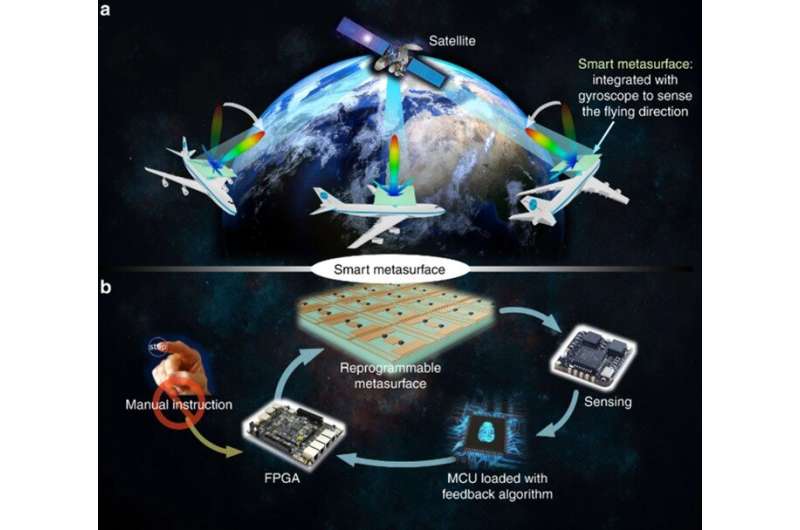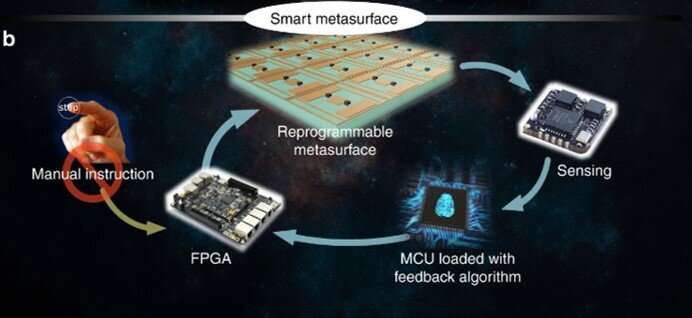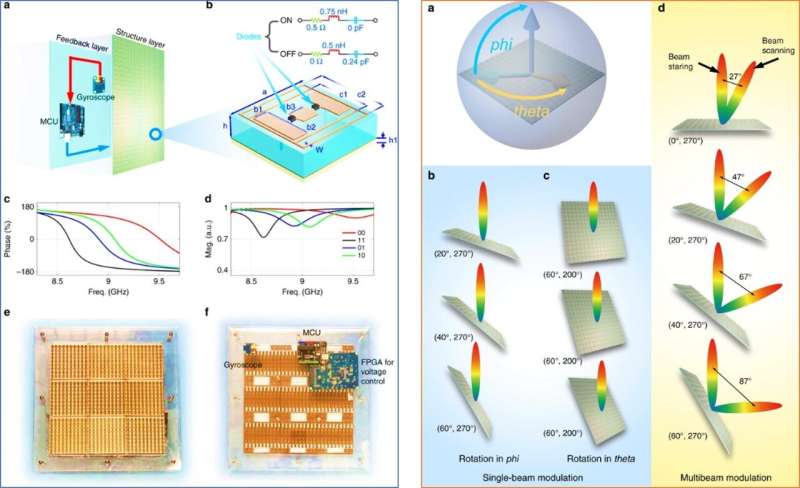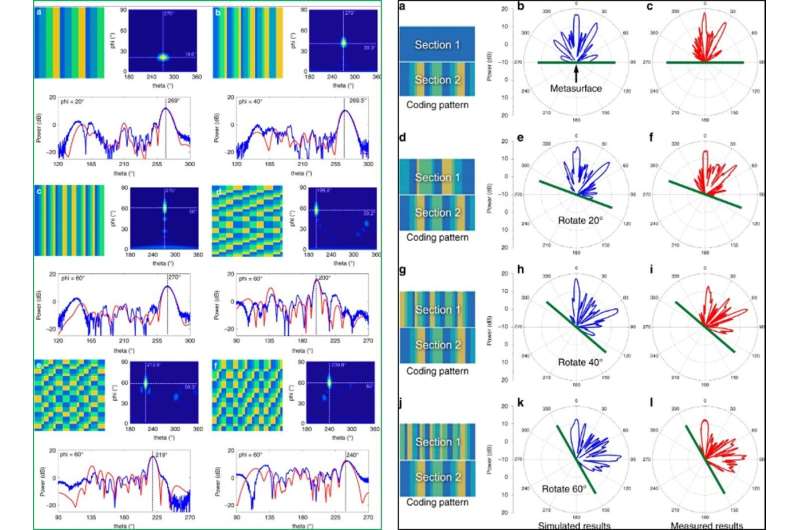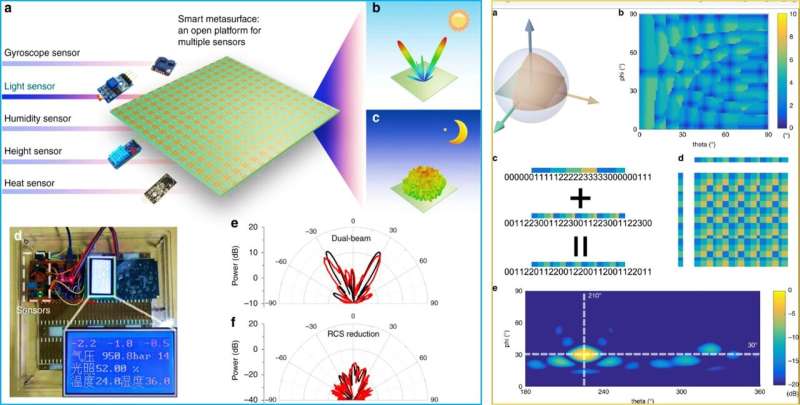The schematic of a smart metasurface. (a) Illustration of the proposed smart metasurface with the self-adaptively reprogrammable functions without manual instruction. (b) The closed-loop system of the smart metasurface, which includes a digital-coding metasurface, an FPGA, a sensor, and a microcontroller unit (MCU) loaded with the fast feedback algorithm. Credit: Light: Science & Applications, doi: 10.1038/s41377-019-0205-3
Materials scientists aim to engineer intelligence into the fabric of materials or metamaterials for programmable functions. Engineering efforts can vary from passive to active forms to develop programmable metasurfaces using dynamic and arbitrary electromagnetic (EM) wavefields. Such metasurfaces, however, require manual control to switch between functions. In a new study now published on Light: Science & Applications, Qian Ma and an interdisciplinary research team in the State Key Laboratory, Cyberspace Science and Technology, and the Department of Electronics in China engineered a smart metasurface for self-adaptive programmability.
Using an unmanned feedback sensing system, the smart metasurface detailed ambient environments with additional sensors, alongside adaptive adjustment of its EM operational functionality. As proof of concept, the team experimentally developed a motion-sensitive smart metasurface integrated into a three-axis gyroscope (to measure or maintain rotational motion) with ability to self-adjust the EM radiation beams by rotating the metasurface. Ma et al. developed an online feedback algorithm within the control software to steer the smart metasurfaces and perform adaptive dynamic reactions. They extended the proposed metasurfaces to physical sensors to program humidity detection, temperature or light illumination. The materials engineering strategy will open a new avenue to develop programmable devices without human participation to sense and detect motion in an ambient environment.
Metamaterials have remarkable electromagnetic properties introduced by their subwavelength structures and functional arrangement. Metasurfaces can overcome challenges typically encountered in bulk metamaterials to strongly manipulate EM waves for wavefront shaping, radiation control and polarization conversion. Due to the versatility of metasurfaces, research teams proposed a variety of applications including imaging, invisibility and illusion, as well as anomalous reflection and refraction; mainly focused on continuous modulations on metasurfaces. To explore new perspectives of metasurfaces, research teams proposed to link metasurface physics and digital information science. To explore the new capabilities of metasurfaces, researchers proposed digital-coding metasurfaces to include physics, information science and digital signal processing. However, such systems remain under human (manual) control.
The schematic of a smart metasurface and the proposed method of study. The closed-loop system of the smart metasurface, which includes a digital-coding metasurface, an FPGA, a sensor, and a microcontroller unit (MCU) loaded with the fast feedback algorithm. Credit: Light: Science & Applications, doi: 10.1038/s41377-019-0205-3
In the present work, Ma et al. proposed and developed a smart digital-coding metasurface with self-adaptive capacity for reprogrammable functionality; implemented by the material surface itself. The metasurface independently used specific feedback modulations for spatial positions and other alterations. The team included a gyroscope sensor, an intelligent control system and fast feedback algorithm into the experimental setup to realize self-adaptive reprogrammable functions—without human aid. The open metasurface platform applied to diverse sensors and their inclusion to achieve elegant sensing-feedback mechanisms. Ma et al. envision the preliminary work will pave the way towards developing intelligent and cognitive metasurfaces in the future.
In the experimental setup, they used a sensor on the metasurface to detect specific features surrounding the construct in the environment and deliver them to a microcontroller unit (MCU). The MCU independently determined reactions to these variations and then instructed the field programmable gate array (FPGA) via coding patterns, to change the metasurface configuration in real time. The smart metasurfaces achieved self-adaptive reprogrammable functionality automatically based on the surface-installed sensing-feedback system and calculation software. The excellent surface compatibility of the MCU allowed Ma et al. to integrate a variety of sensors to the smart metasurface to sense with more degrees of freedom.
LEFT: The structure and performance of the designed 2-bit reprogrammable metasurface. (a) The configuration of the proposed smart metasurface. (b) The detailed unit structure of the 2-bit digital coding metasurface. (c and d) The phase and amplitude responses of the 2-bit digital coding metasurface, with different colors used to indicate four digital states. (e and f ) The front and back views of the fabricated metasurface. RIGHT: The illustration of two schemes for the spatial self-adaptive principle. (a) The illustration for Scheme A: beam steering. (b) The situations where the metasurface rotates by different elevation angles (φ), namely, 20°, 40°, and 60°, in which the azimuth angle is fixed at 270°. (c) The situations where the metasurface rotates by different azimuth angles (θ), namely, 200°, 220°, and 240°, in which the elevation angle is fixed at 60°. (d) The situations for multibeam modulation. When the metasurface rotates, one beam stares at 0°, and the other beam rotates with respect to the metasurface from 0° to 60°. Credit: Light: Science & Applications, doi: 10.1038/s41377-019-0205-3.
To demonstrate the working principles of smart beam manipulation, the team studied a specific situation in satellite communication with a flying airplane. They replaced the traditional devices with a simple, smart metasurface containing a gyroscope sensor and an MCU. During the design, they included the sensor and microcontroller written with the fast inverse design algorithm into the back of a programmable metasurface. They proposed the use of a two-bit digital element containing two PIN diodes to construct the programmable metasurface. The researchers used the equivalent circuits of the PIN diode in the "on" and "off" states within field circuit joint simulations. To understand the performance of adaptive controls, the team presented two (A and B) representative schemes.
For simulations and experimental demonstrations, Ma et al. designed and developed a smart digital-coding metasurface containing 30 x 30 elements. They observed deviations between simulations and measurements in scheme A due to imperfectly printed board manufacturing processes, manual operations errors in the measurement setup, and nonideal plane-wave illumination. For scheme B multibeam modulations, the scientists observed consistency between the simulations and measurements, while the slight error rate between them resulted from non-ideal fabrication and manual operations.
LEFT: The designed digital-coding patterns and the simulated and experimental results for Scheme A, in which the simulated far-field results of the upper half space for the six situations are listed next to the coding patterns; the comparisons between the simulated and experimental far-field results for the six situations are listed below the coding patterns. Here, the simulated and experimental far-field results are marked with red and blue, respectively. (a–c) The three states of rotation in φ, with the deflecting beams at elevation angles of 20°, 40°, and 60°, in which the azimuth angle is fixed at 270°. (d–f) The three states of rotation in θ, with the deflecting beams at azimuth angles of 200°, 220°, and 240°, in which the elevation angle is fixed at 60°. RIGHT: The multiple-beam smart manipulation. (a, d, g, and j) The calculated coding patterns for different rotation states. (b, e, h, and k) The simulated far-field results when the metasurface rotates from 0° to 60°. (c, f, i, and l) The measured far-field results when the metasurface rotates from 0° to 60° Credit: Light: Science & Applications, doi: 10.1038/s41377-019-0205-3.
The smart metasurface showed capacity for extended sensing functions and the ability to include multiple sensors. For example, diverse sensors on the smart metasurface could detect and react to a variety of stimuli. The research team showed the capacity for embedded light sensors to detect the intensity of visible light to produce an intensity percentage. Ma et al. used the sensors to combine visible-optical stimuli with microwave radiation. To validate their design experimentally, the research team developed five sensors including a gyroscope, light sensor, humidity sensor, height sensor and heat sensor on an assembled metasurface. They then demonstrated the light sensing reaction process by simulating and measuring two radiation patterns marked by red and blue lines; in good agreement between the simulations and experiments.
In this way, Ma et al. studied automatic single beam and multiple-beam modulations using the smart metasurface. They precalculated the coding patterns and stored them in the MCU (microcontroller unit) to realize required programmable functions independently of real-time manipulation. Structurally, the metasurface architecture included three main parts; programmable units, an FPGA (field programmable gate array) and sensors. The scientists calculated the coding patterns corresponding to the rotation angles to setup a database stored in the MCU to achieve the required functions in real time. As a result, they developed diverse functions by programming multiple algorithms in the MCU for numerical simulations and experimental verifications.
LEFT: An illustration of the smart metasurface platform. (a) The smart metasurface integrated with multiple sensors. (b and c) The distinct reactions according to the light sensor: dual-beam radiation for the light state and RCS reduction for the dark state. (d) A photograph of the assembled smart metasurface. (e and f) The simulated and measured results for dual-beam radiation and RCS reduction. RIGHT: The coding pattern calculation process and its design error analysis. (a) The illustration for beam deflections in the first quadrant. (b) The error angle distribution for beam deflections in the first quadrant (θ and φ vary from 1° to 90°). (c) The calculation process for the digital-coding sequence. (d) The calculated digital-coding pattern. (e) The simulated far-field result in the upper half space. Credit: Light: Science & Applications, doi: 10.1038/s41377-019-0205-3.
The proposed self-adaptive, digital-coding metasurface contains a complete sensing and feedback mechanism realized as a smart metasurface, without human control. Additional sensors succeeded to connect optical stimuli and microwave modulations. The experimental results agreed well with numerical simulations to validate the adaptive sensing-feedback mechanisms. The research team established a variety of smart metasurfaces in the study, equipped with relevant sensors for expected applications. The proposed concept will offer a new definition for metasurfaces and pave the way towards the development of cognitive and intelligent metamaterials constructs.
More information: Qian Ma et al. Smart metasurface with self-adaptively reprogrammable functions, Light: Science & Applications (2019). DOI: 10.1038/s41377-019-0205-3
J. B. Pendry. Controlling Electromagnetic Fields, Science (2006). DOI: 10.1126/science.1125907
Jong Bum Lee et al. A mechanical metamaterial made from a DNA hydrogel, Nature Nanotechnology (2012). DOI: 10.1038/nnano.2012.211
Journal information: Light: Science & Applications , Science , Nature Nanotechnology
© 2019 Science X Network
